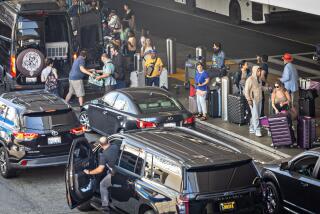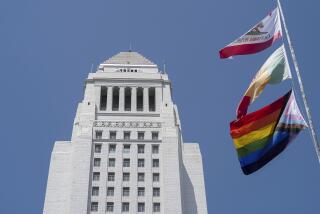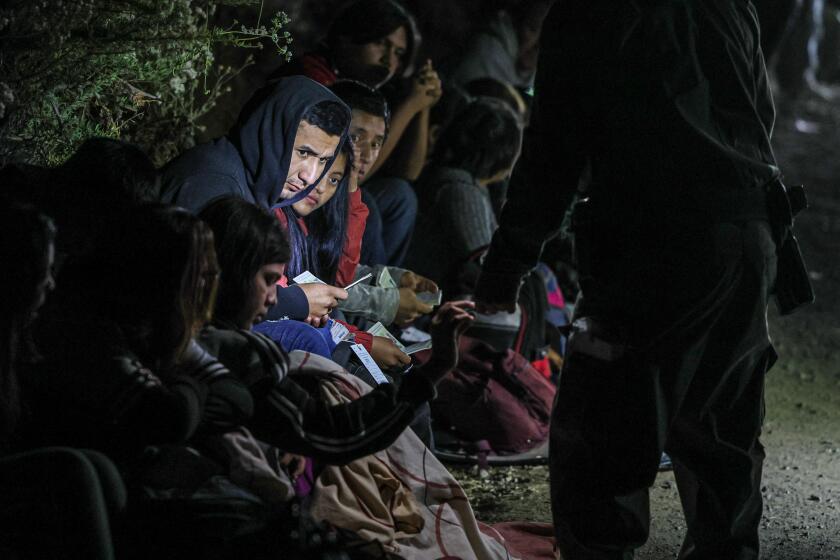Outcry Against Immigration Is Loud in Valley
Residents of the San Fernando Valley are increasingly outraged about illegal immigration--if not immigration generally--in the face of economic hard times, growing congestion, widespread crime and a dramatic influx of Latinos, say lawmakers and community activists.
Valley lawmakers in Washington, in turn, have been in the forefront of those calling for hard-line measures intended to stem the flow of undocumented immigrants.
The Valley has been in the vanguard of a rising backlash throughout Southern California and elsewhere against the tide of newcomers, particularly those crossing the Mexican border, according to voices raised at town meetings and in focus groups, polls and election campaigns.
The outcry--expressed in recent years about issues ranging from day laborers congregating on street corners to undocumented women giving birth at public hospitals--cuts across political and racial lines. It coincides with a major increase regionally in legal and illegal immigrants.
“This is probably the most significant issue discussed in the Valley,” said Richard H. Close, president of the Sherman Oaks Homeowners Assn., who maintains that many Anglos, in particular, are uneasy about the changing demographic face of the community.
“There is a perception that the Valley is being overrun by illegal immigrants who are causing most of the crime, who are causing most of the graffiti and who are causing the physical decline.”
For some, the reaction of Valley residents is a natural outgrowth of onerous burdens--including budget-busting social service, education and criminal-justice costs--thrust upon Southern California by the nation’s porous immigration laws.
But others say that legitimate concerns about pervasive legal violations have been blown out of proportion because immigrants are commonly made scapegoats during tough times for complex economic and social problems.
Certainly, the groundswell has been apparent for some time to members of Congress who represent the Valley. All of them agree that the country’s efforts to stem illegal immigration have largely failed.
Rep. Carlos J. Moorhead (R-Glendale) has sponsored legislation for at least the past four years to beef up the Border Patrol. The House passed a bill in July to add 600 new agents, a step President Clinton endorsed last week.
Rep. Elton Gallegly (R-Simi Valley), who represented parts of the Valley until this year, has called for harsh actions to curtail benefits for illegal residents for the past three years. This includes a highly controversial proposal to amend the Constitution to deny citizenship to the children of undocumented residents born in the United States.
And Rep. Anthony C. Beilenson (D-Woodland Hills) raised eyebrows when he became the first Democrat nationwide to endorse Gallegly’s proposal. The former Westside lawmaker also supports calls for a tamper-proof national identification card for those seeking work--another measure opposed by civil libertarians, who say it will lead to increased discrimination and invasion of privacy.
“There’s been a lot more concern about the (immigration) issue (in the Valley) than I ever heard on the Westside of town,” said Beilenson, who traces his interest back a decade and links it to his preoccupation with the dangers of overpopulation. “People are beginning to feel overwhelmed by the numbers of new people around competing for space, resources, jobs.”
Some Latino activists, noting the Valley’s reputation as a conservative, relatively affluent bastion of bedroom communities, suggest that racism underlies the anger--that the same objections would not be raised if the immigrants were European. At the same time, Latinos and African-Americans also express considerable opposition to illegal immigration, polls show.
And a survey by the Los Angeles Times Poll early this year found that a majority of respondents in every part of the city thought there are too many immigrants--although Valley residents were most inclined to blame illegal immigrants for crime and the economic downturn.
In the poll, 64% of Valley respondents said there are “too many foreign immigrants in Los Angeles” and 58% said that a “great deal” or “good amount” of “crime and street violence” in the city is caused by illegal immigrants. In the same survey, 63% of Latinos and African-Americans citywide said there are too many immigrants in Los Angeles.
The decade of the 1980s saw a historic migration to the Valley. The 1990 census reported that about one-third of the Valley’s 1.2 million residents--or 411,125--are foreign-born, and about half of those residents--214,467--arrived in the 1980s.
Discerning the figure for illegal immigrants in the Valley is more difficult, if not impossible. In Los Angeles County, it is estimated that there are more than 700,000 illegal residents.
Experts say that the forces drawing illegal residents to the Valley are similar to those that have lured ambitious newcomers since the days of the orange groves: economic opportunity and hope for a better life. And many are finding work--provided by longtime residents.
But the Valley’s attributes have also attracted many legal immigrants, although that distinction is lost on some residents.
Gilda Rodriguez, a paralegal with San Fernando Neighborhood Legal Services who works with the county’s day laborer program in North Hollywood, said: “It is difficult for many people to distinguish who is here legally and who is not. They make the assumption that anyone Spanish-speaking is illegal.”
She said that the majority of workers who participate in the county program are Latino and “probably the majority of them are documented--over 50% have some sort of residency or are in the process of applying for citizenship.” In any case, she said, newcomers are generally resented and “unappreciated by the folks benefiting by their presence.”
Following the World Trade Center bombing and the cases of smuggled Chinese aboard vessels along the Pacific Coast, the immigration issue has heated up. President Clinton proposed a series of get-tough initiatives last week. But concern over illegal immigration has long simmered in neighborhoods from Glendale to Agoura.
“We’ve never done a focus group in the Valley where that issue has not come up very prominently,” said Calabasas pollster Arnie Steinberg, who has monitored this concern for a host of candidates for public office.
The issue manifests itself in various ways. Close of Sherman Oaks said he discovered this was not just the domain “of some ultraconservative prejudiced people” when, during a mayoral candidates’ forum early this year, candidate and former Deputy Mayor Tom Houston struck a chord with calls to crack down on illegal immigrants.
Other examples:
* In 1991, Agoura Hills became one of the first communities to pass an ordinance prohibiting day laborers from soliciting work in public places--despite challenges by the American Civil Liberties Union.
* When Clinton visited Valley College in Van Nuys in May, picketers held up signs that said: “L.A. is a Third World Cesspool” and “Deport Illegal Aliens Now.”
* During the mayoral campaign, street vendors emerged as a controversy with business people and voters. “Street vendors tend to be people who look different than someone whose block they might be on, so it takes immigration from being an abstract issue to something you confront personally,” said Assemblyman Richard Katz (D-Sylmar), who was a candidate.
* When newly elected Mayor Richard Riordan dropped by the Los Angeles Police Department’s Van Nuys Station, an officer complained that undocumented residents were a prime source of calls on his beat, but that the police are prohibited by law from turning them over to the Immigration and Naturalization Service.
Members of Congress who represent the Valley say that the issue has arisen for years in mail and phone calls from constituents and in town hall forums.
Freshman Rep. Howard P. (Buck) McKeon (R-Santa Clarita) said that, during such sessions recently, intense concern was expressed by residents in each of the three valleys he represents--the Santa Clarita and Antelope valleys and the northwest San Fernando Valley.
“It’s very big in all three,” said McKeon, who signed on to Gallegly’s six hard-line immigration bills shortly after taking office. “They’re concerned it has impact on education, it has impact on welfare. We have to pay for hospitalization of people who are here illegally, and they just feel that’s unfair, especially when we’re having such budget shortfalls.”
Undocumented residents are not eligible for federal welfare and some other government programs but they can receive emergency medical care--including prenatal and childbirth care. Two-thirds of all mothers who delivered at the four Los Angeles County-run medical centers in the 1990-91 fiscal year were undocumented, according to a county Health Department survey.
The influx has strained states and localities--including hard-pressed Los Angeles County. In an often-cited study, the county calculated that the net cost of providing public services to its estimated 700,000 illegal residents was $308 million in the 1991-92 fiscal year.
Immigrant rights advocates say that such studies tend to overestimate the costs of illegal residents and underestimate the benefits, including the sales, property and Social Security taxes that many pay. But they acknowledge that there are significant costs to states and localities--mostly because a large portion of the revenue goes to the federal government and the costs associated with illegal immigrants tend to be at the local level.
Rep. Howard L. Berman (D-Panorama City) and, more recently, Reps. Henry A. Waxman (D-Los Angeles) and Moorhead, have fought for additional federal reimbursement for California for health and education costs of new immigrants.
Fewer statistics are available regarding crime. Nationally, Atty. Gen. Janet Reno points out that 26% of federal prisoners are in the United States illegally. The county study found that $110.6 million was spent to move illegal residents through the judicial system. And Rep. McKeon said law enforcement officials have told him that “a high percentage of crime is caused by a small percentage of illegals.”
But the Los Angeles Police Department is forbidden to ask those arrested about their immigration status.
“We just don’t know because we don’t keep statistics relating to illegal aliens and the amount of crime that can be attributed to them,” Officer Arthur Holmes said. “We just don’t have any hard information.”
Assemblyman Katz said that public perception is shaped for many when they “hear about Asian gangs, hear about Latino gangs and people make assumptions.” He added that “illegal aliens are potentially greater victims of crime because, given their status, they can’t report crimes or won’t report crimes.”
Rudy Acuna, a professor of Chicano Studies at Cal State Northridge, says that the anti-immigrant sentiment is fueled by “bigoted whites” and fanned by demagogic politicians and media coverage.
“A lot of people here in West Valley weren’t upset when there were people coming over from Eastern Europe,” said Acuna, a Valley resident since 1959. “All of a sudden, because the people are black and Haitian or brown and Mexican or South American, they’re all upset. They want to blame someone for the failure of the economy in Southern California. It wasn’t the undocumented worker who pulled out the factories.”
Other Latino activists likened the backlash to the movement opposing mandatory school busing that swept the Valley in the 1970s.
“The Bustop movement came out of the San Fernando Valley,” said Vibiana Andrade, legal program director of the Mexican American Legal Defense and Educational Fund in Los Angeles. “Because the world suddenly changes, it results in people being afraid. . . . Sometimes this results in intolerance.”
Berman, a champion of legal immigration, says that the debate is suffused with mythology. “The vast majority of people who come here to work illegally are not criminals, they’re not welfare recipients,” he said. “The work ethic burns strongly in them.”
Berman backs reforms to stem illegal immigration--including a better trained and more effective Border Patrol, a joint effort with the Mexican government to stop the flow of workers and a tamper-resistant work document to enforce employer sanctions.
Further, he said, the need to reform a welfare system that makes it “more rewarding to get welfare than to get work” is far more critical to the future of the unskilled labor force than competition from illegal immigrants.
“Just as mandatory busing was not the source of all the problems in the Los Angeles public schools--and the ending of it did not make things fine in public education--crime, welfare dependency and deteriorating neighborhoods involve issues far larger than just illegal immigration,” Berman said. “If you could create an imaginary wall and have no new immigrants tomorrow, you would still have these problems.”
More to Read
Start your day right
Sign up for Essential California for news, features and recommendations from the L.A. Times and beyond in your inbox six days a week.
You may occasionally receive promotional content from the Los Angeles Times.






